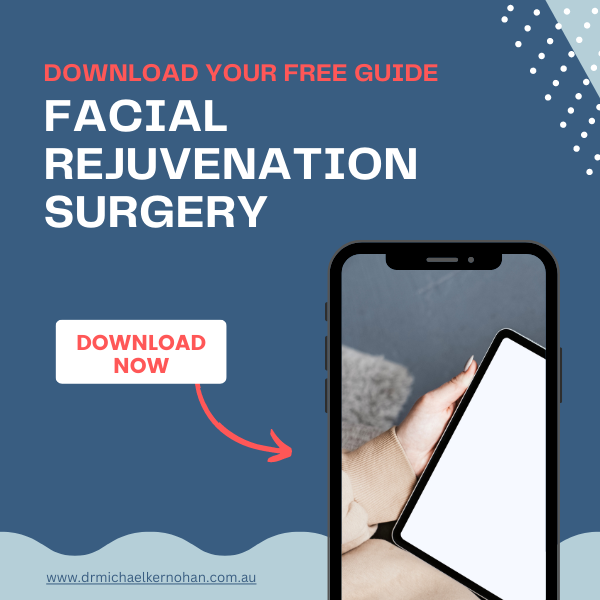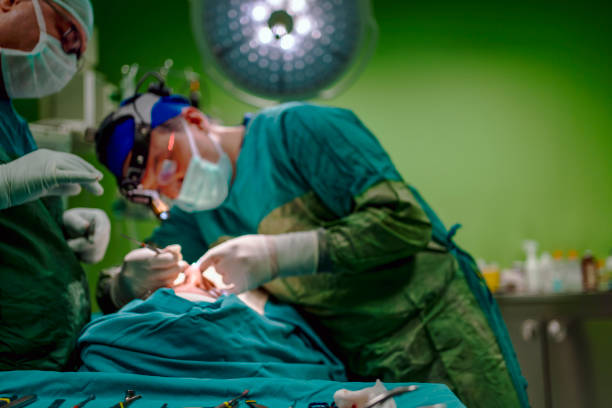What Is Eyelid Ptosis and How Eyelid Surgery Can Enhance Vision
Eyelid ptosis might be more than just a cosmetic concern. Eyelid ptosis is a condition where the upper eyelid descends to a lower position than normal. This might result from a variety of factors, including age, injury, or certain medical conditions.
While in some cases, eyelid ptosis is a minor issue that doesn’t affect vision or appearance significantly, in other instances, it can be quite severe, leading to significant visual impairment and a marked change in appearance.
Sydney Specialist Plastic Surgeon Michael Kernohan performs eyelid surgery and other surgical and non-surgical procedures.
Click to Download Dr Michael Kernohan’s Facial Rejuvenation Guide

Causes of Eyelid Ptosis
Eyelid ptosis isn’t a condition that discriminates. It can affect people of all ages, from infants to the elderly. The causes of eyelid ptosis are varied and can be broadly categorised into two groups: acquired and congenital.
Acquired eyelid ptosis, which is more common, typically results from the ageing process. As you age, the muscle that lifts your eyelid, known as the levator muscle, can weaken, causing your eyelid to droop. Other causes of acquired eyelid ptosis include nerve problems, eye surgeries, or injury to the eye area.
Congenital eyelid ptosis, on the other hand, is present at birth. This condition occurs when the levator muscle doesn’t develop properly in the womb. While less common, it’s imperative to address this form of ptosis early to prevent developmental vision problems.
Symptoms of Eyelid Ptosis
Eyelid ptosis, while often identified by the hallmark drooping of the upper eyelid, presents a range of symptoms that can vary in intensity and impact on daily life:
- Asymmetry in Eye Appearance: One of the initial signs that many individuals notice is an asymmetry between the two eyes. While one eye might appear normal, the other may have a noticeable droop. This unevenness can be especially evident in photographs or when looking in the mirror
- Intermittent Drooping: For some, the drooping isn’t constant. They might start the day with relatively lifted eyelids, but as the day progresses and muscles tire, the droop becomes more pronounced
- Frequent Brow Lifting: To lift the sagging skin and improve the field of vision, many raise their eyebrows often
- Head Tilting: Some might tilt their head backward to see underneath the drooping eyelid, especially when trying to focus on something above eye level
- Squinting: Narrowing the eyes can sometimes temporarily alleviate the droop and enhance vision
- Physical Discomfort: Beyond the visual disturbances, eyelid ptosis can manifest in physical discomfort
- Eye Strain: The continuous effort to see clearly can strain the eye muscles, leading to a feeling of heaviness or tiredness in the eyes
- Fatigue: The constant compensatory behaviours and muscle strain can lead to overall fatigue, especially by the end of the day
- Headaches: The strain and the frequent eyebrow lifting can trigger tension headaches, often felt around the forehead area
- Difficulty in Routine Tasks: The impaired vision caused by the drooping eyelid can make daily tasks challenging. Reading might require constant adjustments to find the right angle, and driving, especially at night, can become hazardous due to the reduced field of vision
- Dryness or Excessive Tearing: In some cases, the eyelid’s altered position can affect the eye’s ability to lubricate itself properly. This can lead to symptoms of dry eyes or, paradoxically, excessive tearing as the eye tries to compensate
While the drooping eyelid is the most visible symptom of eyelid ptosis, the condition’s ramifications extend beyond aesthetics. It impacts vision, daily functioning, and overall well-being. Recognising these symptoms early can pave the way for timely interventions.
Blepharoplasty – The Eyelid Surgery

Blepharoplasty, or eyelid surgery, is a procedure designed to correct droopy eyes caused by eyelid ptosis. This surgery involves the removal or tightening of excess skin and muscle in the upper eyelid, restoring it to its normal position and improving vision and appearance.
This procedure is usually performed by a plastic surgeon. It is often done under local anaesthesia on an outpatient basis, meaning you’ll be able to go home the same day. Some patients require a general anaesthetic, which may involve an overnight stay in hospital and additional costs.
Your process to get eyelid surgery begins with a comprehensive eye examination, where your plastic surgeon will assess the severity of your ptosis and determine if you’re a good candidate for surgery.
During the procedure, your plastic surgeon will make a small incision in the natural crease of your eyelid. Through this incision, they will tighten the levator muscle, effectively raising the position of your eyelid. Once the surgery is completed, the incision will be closed with sutures, and you’ll be ready to start your recovery journey.
Blepharoplasty offers numerous benefits, the foremost being improved vision. By correcting the drooping eyelid, this surgery can help eliminate the visual impairment caused by eyelid ptosis, making everyday tasks easier and safer.
Recovery from eyelid surgery is generally straightforward. Immediately after the procedure, you might experience some swelling, bruising, and discomfort in the eye area. These symptoms are normal and should subside within a week or two. Dr Kernohan will provide specific post-operative care instructions to ensure a smooth recovery. This will likely include using cold compresses to minimise swelling, taking prescribed medications to control pain, and avoiding strenuous activities. You’ll also have several follow-up appointments with your plastic surgeon. During these visits, Dr Kernohan will monitor your healing progress and address any concerns you might have.
Alternatives to Blepharoplasty to Correct Eyelid Ptosis
While blepharoplasty is a common surgical solution, there are several non-surgical alternatives:
- Muscle Relaxant Injections: By injecting muscle relaxant substances into the muscles that elevate the eyelid, a temporary lift to the drooping eyelid can be achieved. This minimally invasive and quick procedure offers an immediate solution with no downtime. However, it’s a temporary solution that requires repeat treatments every few months
- Fillers: Dermal fillers, like hyaluronic acid, can be used to provide volume and support to the upper eyelid area, resulting in a lifted appearance. The procedure offers immediate results and is minimally invasive. On the downside, it’s temporary and there’s potential for bruising or swelling
- Ptosis Crutches: These small attachments added to eyeglasses support the eyelid and prevent it from drooping. They are non-invasive and can be easily removed, but are only effective when wearing glasses and might be uncomfortable for some
- Laser Treatments: Lasers can be employed to tighten and rejuvenate the skin around the eyes, which not only lifts the eyelids but also addresses fine lines and wrinkles. While the treatment is non-invasive, multiple sessions might be required, and there’s potential for redness or swelling
- Thermage: Using radiofrequency energy, Thermage tightens the skin around the eyes, offering a non-invasive solution with long-lasting results. Keep in mind that the treatment can be painful, and there might be temporary redness or swelling
- Ultherapy: This treatment uses ultrasound energy to lift and tighten the skin around the eyes. It’s non-invasive and stimulates collagen production, but can be uncomfortable and might require multiple sessions
- Acupuncture: By stimulating certain points around the eyes, acupuncture can potentially lift drooping eyelids. It’s a natural method that can also promote overall well-being. Results vary, and multiple sessions are required
- Topical Treatments: Creams and serums with ingredients like peptides and retinoids can offer a slight lift and firmness to the eyelid skin. These non-invasive treatments can be incorporated into a daily skincare routine, but results are generally subtle and temporary
Eyelid ptosis is more than just a cosmetic issue. It is a condition that can significantly impact your vision and appearance. But with a better understanding of this condition and the surgical options available, you can take the necessary steps to overcome eyelid ptosis.
While eyelid surgery can offer significant benefits, it’s essential to discuss this option thoroughly with your plastic surgeon. Dr Kernohan can provide personalised advice based on your unique situation, ensuring you make the best decision for your particular case.
FAQs about Eyelid Ptosis

What are the potential risks associated with blepharoplasty?
- Like any surgical procedure, blepharoplasty comes with its set of risks, including infection, bleeding, scarring, dry eyes, difficulty closing the eyes, and, in rare cases, loss of vision. It’s essential to discuss these risks with your plastic surgeon and understand the precautions taken to minimise them.
How long does the effect of blepharoplasty last?
- The results of blepharoplasty are generally long-lasting. While the surgery can’t halt the natural ageing process, most patients find that the procedure’s benefits last for many years. Regular skincare and sun protection can help maintain the results longer.
Are there non-surgical alternatives to treat eyelid ptosis?
- While surgery is the most definitive treatment for eyelid ptosis, there are non-surgical options that may provide temporary relief or improvement. These can include muscle relaxant injections, special ptosis crutches fitted to glasses, or fillers. However, the effectiveness of these treatments varies, and they may not be suitable for all patients.
How can I determine if my droopy eyelids are a result of eyelid ptosis or another condition?
- A comprehensive eye examination by an ophthalmologist can determine the cause of droopy eyelids. While eyelid ptosis is a common cause, other conditions like dermatochalasis (excess upper eyelid skin) or brow ptosis (drooping of the eyebrows) can also lead to a similar appearance.
Will insurance cover the cost of blepharoplasty?
- If the drooping eyelid is affecting your vision significantly, and this can be documented through specific tests, insurance may cover the procedure as a medically necessary surgery. But if the surgery is sought primarily for cosmetic reasons, it’s less likely to be covered. It’s essential to check with your insurance provider and discuss this with your plastic surgeon during the initial consultation.
Further Reading about Eyelid Surgery with Dr Kernohan
- Read Dr Kernohan’s Upper Eyelid Surgery NSW Page
- Read Dr Kernohan’s Lower Eyelid Surgery Sydney Page
- Read Dr Kernohan’s Blog about Recovery after Eyelid Surgery – Healing after Blepharoplasty
- Read Dr Kernohan’s Blog about What are Heavy Eyelids?
- Read Dr Kernohan’s Blog about What Are Hooded Eyes?
- Read Dr Kernohan’s Blog about Will Medicare Cover Eyelid Surgery?
- Read Dr Kernohan’s Blog about Eyelid Surgery in Your 30s, 40s, 50s and 60s
- Read Dr Kernohan’s Blog about Eyelid Surgery Scar Treatment Healing and Fading
Medical References about Eyelid Surgery
- Upper Eyelid Blepharoplasty
- How To Fix Droopy Eyelids, Circles and Sags – Cleveland Clinic
- Blepharoplasty – Mayo Clinic
- Eyelid Reduction Surgery – ASPS





